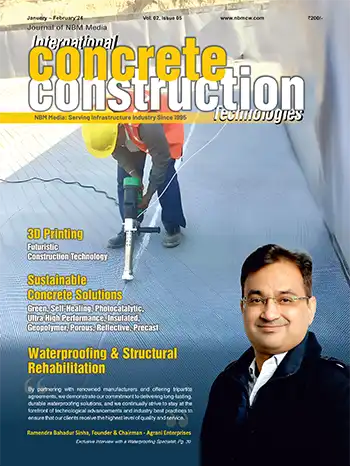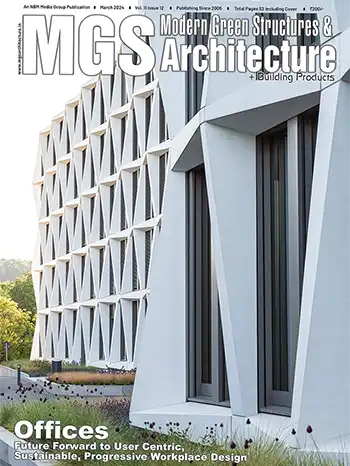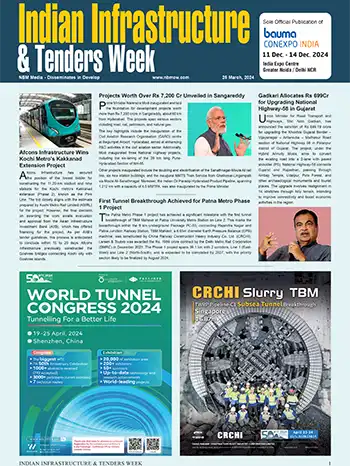Polypropylene Fiber Reinforced Concrete : An Overview
The capability of durable structure to resist weathering action, chemical attack, abrasion and other degradation processes during its service life with the minimal maintenance is equally important as the capacity of a structure to resist the loads applied on it. Although concrete offers many advantages regarding mechanical characteristics and economic aspects of the construction, the brittle behavior of the material remains a larger handicap for the seismic and other applications where flexible behaviour is essentially required. Recently, however the development of polypropylene fiber-reinforced concrete (PFRC) has provided a technical basis for improving these deficiencies. This paper presents an overview of the effect of polypropylene (PP) fibers on various properties of concrete in fresh and hardened state such as compressive strength, tensile strength, flexural strength, workability, bond strength, fracture properties, creep strain, impact and chloride penetration. The role of fibers in crack prevention has also been discussed.
S. K. Singh, Scientist, Structural Engineering Division, Central Building Research Institute, Roorkee & Honorary Secretary Institute of Engineers, Roorkee
Introduction
Ceramics were the first engineering materials known to mankind and they still constitute the most used materials in terms of weight [1, 2]. Hydraulic cements and cement-based composites including concretes are the main ceramic-based materials. Concrete offers many advantages in the application due to its improved mechanical characteristics, low permeability and higher resistance against chemical and mechanical attacks. Although concrete behavior is governed significantly by its compressive strength, the tensile strength is important with respect to the appearance and durability of concrete. The tensile strength of concrete is relatively much lower. Therefore, fibers are generally introduced to enhance its flexural tensile strength, crack arresting system and post cracking ductile behaviour of basic matrix.
Concrete modification by using polymeric materials has been studied for the past four decades [3]. In general, the reinforcement of brittle building materials with fibers has been known from ancient period such as putting straw into the mud for housing walls or reinforcing mortar using animal hair etc. Many materials like jute, bamboo, coconut, rice husk, cane bagasse, and sawdust as well as synthetic materials such as polyvinyl alcohol, polypropylene (PP), polyethylene, polyamides etc. have also been used for reinforcing the concrete [4,5,6,7,8]. Research and development into new fiber reinforced concrete is going on today as well.
Polypropylene fibers were first suggested as an admixture to concrete in 1965 for the construction of blast resistant buildings for the US Corps of Engineers. The fiber has subsequently been improved further and at present it is used either as short discontinuous fibrillated material for production of fiber reinforced concrete or a continuous mat for production of thin sheet components. Since then the use of these fibers has increased tremendously in construction of structures because addition of fibers in concrete improves the toughness, flexural strength, tensile strength and impact strength as well as failure mode of concrete. Polypropylene twine is cheap, abundantly available, and like all manmade fibers of a consistent quality.
Concrete modification by using polymeric materials has been studied for the past four decades [3]. In general, the reinforcement of brittle building materials with fibers has been known from ancient period such as putting straw into the mud for housing walls or reinforcing mortar using animal hair etc. Many materials like jute, bamboo, coconut, rice husk, cane bagasse, and sawdust as well as synthetic materials such as polyvinyl alcohol, polypropylene (PP), polyethylene, polyamides etc. have also been used for reinforcing the concrete [4,5,6,7,8]. Research and development into new fiber reinforced concrete is going on today as well.
Polypropylene fibers were first suggested as an admixture to concrete in 1965 for the construction of blast resistant buildings for the US Corps of Engineers. The fiber has subsequently been improved further and at present it is used either as short discontinuous fibrillated material for production of fiber reinforced concrete or a continuous mat for production of thin sheet components. Since then the use of these fibers has increased tremendously in construction of structures because addition of fibers in concrete improves the toughness, flexural strength, tensile strength and impact strength as well as failure mode of concrete. Polypropylene twine is cheap, abundantly available, and like all manmade fibers of a consistent quality.
Properties of Polypropylene Fibers
The raw material of polypropylene is derived from monomeric C3H6 which is purely hydrocarbon. Its mode of polymerization, its high molecular weight and the way it is processed into fibers combine to give polypropylene fibers very useful properties as explained below [9]:
- There is a sterically regular atomic arrangement in the polymer molecule and high crystallinity. Due to regular structure, it is known as isotactic polypropylene.
- Chemical inertness makes the fibers resistant to most chemicals. Any chemical that will not attack the concrete constituents will have no effect on the fiber either. On contact with more aggressive chemicals, the concrete will always deteriorate first.
- The hydrophobic surface not being wet by cement paste helps to prevent chopped fibers from balling effect during mixing like other fibers.
- The water demand is nil for polypropylene fibers.
- The orientation leaves the film weak in the lateral direction which facilitates fibrillations. The cement matrix can therefore penetrate in the mesh structure between the individual fibrils and create a mechanical bond between matrix and fiber.

|

|
| Figure 1: monofilament fiber | Figure 2: Fibrillated fiber |
Role of Fibers
Cracks play an important role as they change concrete structures into permeable elements and consequently with a high risk of corrosion. Cracks not only reduce the quality of concrete and make it aesthetically unacceptable but also make structures out of service. If these cracks do not exceed a certain width, they are neither harmful to a structure nor to its serviceability. Therefore, it is important to reduce the crack width and this can be achieved by adding polypropylene fibers to concrete [13]. The bridging of cracks by the addition of PP fibers has been shown in Fig 3.
Thus addition of fibers in cement concrete matrix bridges these cracks and restrains them from further opening. In order to achieve more deflection in the beam, additional forces and energies are required to pull out or fracture the fibres. This process, apart from preserving the integrity of concrete, improves the load-carrying capacity of structural member beyond cracking. This improvement creates a long post-peak descending portion in the load deflection curve as shown in Fig 4 [12]. Reinforcing steel bars in concrete have the same beneficial effect because they act as long continuous fibres. Short discontinuous fibres have the advantage, however, of being uniformly mixed and dispersed throughout the concrete.
The major reasons for crack formation are Plastic shrinkage, Plastic settlement, Freeze thaw damage, Fire damage etc.
Plastic shrinkage: It occurs when surface water evaporates before the bleed water reaches the surface. Polypropylene fibers reduce the plastic shrinkage crack area due to their flexibility and ability to conform to form. The addition of 0.1% by volume of fibers is found effective in reducing the extent of cracking by a factor of 5-10. The extent of crack reduction is proportional to the fiber content in the concrete.
Plastic settlement: High rate of bleeding and settlement combined with restraint to settlement (e.g. by reinforcing bars) leads to settlement cracking. In case of PFRC, fibers are uniformly distributed. Fibers are flexible so they cause negligible restraint to settlement of aggregates.
Freeze thaw damage: Small addition of polypropylene fibers in concrete reduces the flow of water through the concrete matrix by preventing the transmission of water through the normal modes of ingress, e.g. capillaries, pore structure, etc. The implications of these qualities in concrete with polypropylene fiber additions are that cement hydration will be improved, separation of aggregate will be reduced and the flow of water through concrete that causes deterioration from freeze/ thaw action and rebar corrosion will be reduced, creating an environment in which enhanced durability may take place.
Fire damage: Heat penetrates the concrete resulting in desorption of moisture in outer layer. Moisture vapors flow back towards the cold interior and are reabsorbed into voids. Water and vapor accumulate in the interior thereby increasing the vapor pressure rapidly causing cracks and spalling in the concrete. In case of PFRC, the fibers melt at 160oC creating voids in the concrete. The vapor pressure is released in newly formed voids and explosive spalling is significantly reduced as shown in fig 5[14].
Thus addition of fibers in cement concrete matrix bridges these cracks and restrains them from further opening. In order to achieve more deflection in the beam, additional forces and energies are required to pull out or fracture the fibres. This process, apart from preserving the integrity of concrete, improves the load-carrying capacity of structural member beyond cracking. This improvement creates a long post-peak descending portion in the load deflection curve as shown in Fig 4 [12]. Reinforcing steel bars in concrete have the same beneficial effect because they act as long continuous fibres. Short discontinuous fibres have the advantage, however, of being uniformly mixed and dispersed throughout the concrete.
The major reasons for crack formation are Plastic shrinkage, Plastic settlement, Freeze thaw damage, Fire damage etc.
Plastic shrinkage: It occurs when surface water evaporates before the bleed water reaches the surface. Polypropylene fibers reduce the plastic shrinkage crack area due to their flexibility and ability to conform to form. The addition of 0.1% by volume of fibers is found effective in reducing the extent of cracking by a factor of 5-10. The extent of crack reduction is proportional to the fiber content in the concrete.
| Table 1: Properties of various types of polypropylene fibers | ||||||
| Fiber type | Length (mm) | Diameter (mm) | Tensile strength (MPa) | Modulus of elasticity (GPa) | Specific surface (m2/kg) | Density (kg/cm3) |
| monofilament | 30-50 | 0.30-0.35 | 547-658 | 3.50-7.50 | 91 | 0.9 |
| microfilament | 12-20 | 0.05-0.20 | 330-414 | 3.70-5.50 | 225 | 0.91 |
| Fibrillated | 19-40 | 0.20-0.30 | 500-750 | 5.00-10.00 | 58 | 0.95 |
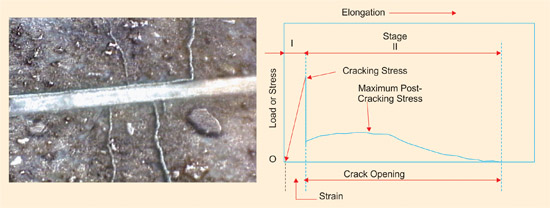
|
|
| Figure 3: Bridging of crack using Polypropylene fibers | Figure 4: Typical load-elongation response in tension of FRC. |
Plastic settlement: High rate of bleeding and settlement combined with restraint to settlement (e.g. by reinforcing bars) leads to settlement cracking. In case of PFRC, fibers are uniformly distributed. Fibers are flexible so they cause negligible restraint to settlement of aggregates.
Freeze thaw damage: Small addition of polypropylene fibers in concrete reduces the flow of water through the concrete matrix by preventing the transmission of water through the normal modes of ingress, e.g. capillaries, pore structure, etc. The implications of these qualities in concrete with polypropylene fiber additions are that cement hydration will be improved, separation of aggregate will be reduced and the flow of water through concrete that causes deterioration from freeze/ thaw action and rebar corrosion will be reduced, creating an environment in which enhanced durability may take place.
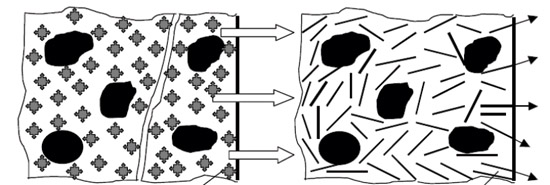
|
|
| Spalling of homogenous structure of Concrete due to insufficient capillary pores | Developed explosion channels due to melting of PP fibers |
| Figure 5: Flowing out of steam pressure through the melted PP fibers in the case of fire | |
Fire damage: Heat penetrates the concrete resulting in desorption of moisture in outer layer. Moisture vapors flow back towards the cold interior and are reabsorbed into voids. Water and vapor accumulate in the interior thereby increasing the vapor pressure rapidly causing cracks and spalling in the concrete. In case of PFRC, the fibers melt at 160oC creating voids in the concrete. The vapor pressure is released in newly formed voids and explosive spalling is significantly reduced as shown in fig 5[14].
Properties of PP Fiber Reinforced Concrete
Before mixing the concrete, the fiber length, amount and design mix variables are adjusted to prevent the fibers from balling. Good FRC mixes usually contain a high mortar volume as compared to conventional concrete mixes. The aspect ratio for the fibers are usually restricted between 100 and 200 since fibers which are too long tend to "ball" in the mix and create workability problems. As a rule, fibers are generally randomly distributed in the concrete; however, placing of concrete should be in such a manner that the fibers become aligned in the direction of applied stress which will result in even greater tensile and flexural strengths. There should be sufficient compaction so that the fresh concrete flows satisfactorily and the PP fibers are uniformly dispersed in the mixture. The fibers should not float to the surface nor sink to the bottom in the fresh concrete. Chemical admixtures are added to fiber-reinforced concrete mixes primarily to increase the workability of the mix. Air-entraining agents and water-reducing admixtu- res are usually added to mixes with a fine aggregate content of 50% or more. Superplasticizers, when added to fiber-reinforced concrete, can lower water: cement ratios, and improve the strength, volumetric stability and handling characteristics of the wet mix. The properties of PFRC with various fiber volume % are shown in Table 2.
Polypropylene fibers are used in two different ways to reinforce cementitious matrices. One application is in thin sheet components in which polypropylene provides the primary reinforcement. Its volume content is relatively high exceeding 5%, in order to obtain both strengthening and toughening. In other application the volume content of the polypropylene is low, less than 0.3% by volume, and it is intended to act mainly as secondary reinforcement for crack control, but not for structural load bearing applications [11]. The performance and influence of the polypropylene fibers in the fresh and hardened concrete is different and therefore these two topics are treated separately.
Effects on Fresh Concrete
The main parameter, which is often used to determine the workability of fresh concrete, is the slump test. The slump value depends mainly on the water absorption and porosity of the aggregates, water content in the mixture, amount of the aggregate and fine material in the mixture, shape of the aggregates and surface characteristics of the constituents in the mixture. The slump values decrease significantly with the addition of polypropylene fibers as shown in Table 3. The concrete mixture becomes rather clingy resulting in increasing of the adhesion and cohesiveness of fresh concrete. During mixing the movement of aggregates shears the fibrillated fibers apart, so that they open into a network of linked fiber filaments and individual fibers. These fibers anchor mechanically to the cement paste because of their large specific surface area. The concrete mixture with polypropylene fibers results in the fewer rate of bleeding and segregation as compared to plain concrete. This is because the fibers hold the concrete together and thus slow down the settlement of aggregates. Due to its high tensile and pull-out strength, the PP fibers even reduce the early plastic shrinkage cracking by enhancing the tensile capacity of fresh concrete to resist the tensile stresses caused by the typical volume changes. The fibers also distribute these tensile stresses more evenly throughout the concrete. As the plastic shrinkage cracking decreases, the number of cracks in the concrete under loading is reduced, due to decrease in cracks from the existing shrinkage cracks. If shrinkage cracks are still formed, the fibers bridge these cracks, reducing at the same time their length and width. Moreover, as the rate of bleeding decreases, the use of polypropylene fibers may accelerate the time to initial and final set of the concrete as this led to a slower rate of drying in the concrete [14].
Effects on Hardened Concrete
The addition of polypropylene fibres in the concrete did not significantly affect the compressive strength and the modulus of elasticity but they do increase the tensile strength. Splitting tensile strength of PFRC approx ranges from 9% to 13% of its compressive strength. Addition of PP fibers in concrete increases the splitting tensile strength by approx 20% to 50% [16].
Compressive strength: The compression strength of concrete is a vital parameter as it decides the other parameters like tension, flexure etc. The effect of polypropylene fiber on the compressive strength of concrete has been discussed in many literatures and observed that polypropylene fiber either decreases or increases the compressive strength of concrete, but overall effect is negligible in many cases. In fact, the effect of a low volume of polypropylene fiber on the compressive strength of concrete may be concealed by the experimental error.
Flexural tensile strength: The flexural tensile strength increases with increase in volume fraction of fiber. It is also observed that there was increase in strength for with the increase in aspect ratio of fibre.
Bond strength: It is necessary that there should be a good bond between the fiber and the matrix. If the critical fiber volume for strengthening has been reached then it is possible to achieve multiple cracking. This is a desirable situation because it changes a basically brittle material with a single fracture surface to fracture into a pseudo ductile material which can absorb transient minor overload and shocks with little visible damage. So the aim is to produce large number of multiple cracks at as close spacing as possible so that the crack widths are very small, almost invisible to naked eye so that the rate at which aggressive materials can penetrate the matrix is reduced. High bond strength helps to give close crack spacing but it is also essential that the fibers should give sufficient ductility to absorb impacts. But in terms of physiochemical adhesion there is no bond between the fiber and the cement gel. The use of chopped and twisted fibrillated polypropylene fibers with their open structure has partially remedied the lack of interfacial adhesion by making use of wedge action at the slightly open fiber ends and also by mechanical bonding through fibrillation. The general pull out loads of twisted fibrillated fibers [20, 21] may range from 300-500N for commonly used staples but the accurate calculation of bond strength is complicated by a lack of knowledge of the surface area of fiber in contact with the paste. It is observed that in damaged products and in broken specimens, usually fiber breaks instead of fiber pull out [9].
Fracture Properties: The failure behaviour of high-strength concretes is effectively improved by the use of fibers. The typical shear bond rupture due to strain localization could be avoided (fig. 6). Instead of this, a large number of the longitudinal cracking, which was predominantly oriented in the direction parallel or sub-parallel to the external compressive stresses, was formed at the entire concrete specimens as shown in fig7.
Creep and shrinkage properties of concrete: Fibers reduce creep strain, which is defined as the time-dependent deformation of concrete under a constant stress. Compressive creep values, however, may be only 10 to 20% of those for normal concrete. Shrinkage of concrete, which is caused by the withdrawal of water from concrete during drying, is also reduced by fibers. The shrinkage, creep and total time dependent deformation of various PFRC mixes along with non fibrous concrete mix are presented in fig 8[15]. The reduction in shrinkage due to the presence of fibers is expected from number of viewpoints. First, the fibers do not exhibit any shrinkage, thus reducing overall shrinkage of the mix. In addition the fibers have a role in retaining the water in the concrete mix upto a certain limit which helps to delay the shrinkage. Therefore addition of fibers to the concrete mixes is always advantageous in reducing shrinkage deformation.
Flexural impact properties: The number of blows required to develop the first visible crack on the beam’s lower surface is defined as the initial-crack impact number (Ncr). Failure impact number Nf is defined as the number at which one main macro-crack develops from bottom to top of the beam. Impact ductility index is defined as the ratio of failure impact number to initial crack impact number, which can be used to present the flexural impact ductility.
J=Nf / Ncr
where J is impact ductility index, which for plain concrete is 1. The flexural impact test results are shown in table 6 by researcher[10]. The impact resistance for concretes with various volume fractions of fibrillated polypropylene fibers has been shown in figure 10. The results indicate that significant improvement in impact resistance of concrete can be achieved with relatively low volume fraction of polypropylene fibers.
Chloride penetration: Besides improved mechanical properties due to inclusion of fiber, chloride penetration is also reduced substantially by the presence of fibers depending upon its orientation. Antoni [17] studied the effect of chloride penetration and found that the effect is insignificant for shorter fiber due to the random orientation of short fibers as compare to long fibers. Further, the chloride movement into concrete is reduced significantly by the presence of fiber as the interfacial transition zone in the direction perpendicular to the chloride penetration whereas fiber provides easier path for the chloride to migrate in direction along the fiber.
| Table 2 Mechanical Properties of Polypropylene Fiber Reinforced Concrete | ||||||||||||||
| No | Concrete mix | Fibers | Vf % | fcu (MPa) | ft (MPa) | fs (MPa) | Slump (mm) | Ref. | ||||||
| w/c | Cement (kg/m3) | CA (kg/m3) | FA (kg/m3) | Admixture | Specimen shape | Type | l/d | |||||||
| 1. | 0.49 | 390 (OPC) | 1000 (10mm) | 640 | Super plasticizer (Fosroc 430) | Cylinder, Cubes & Prism | Fibrillated (20mm long & 0.29mm dia) |
69 | 0 0.10 0.30 | 17.2 14.1 12.6 |
1.08 1.72 1.34 | 4.5 2.5 3.0 |
100 – 120 | [15] |
| 2. | 0.45 | 360 (OPC) | 1100 (20mm) | 647 | - | Prism | Micro filament (19mm long & 0.048mm dia) |
396 | 0 0.045 0.082 0.128 | - - - - |
2.24 2.33 2.40 2.43 |
4.01 3.76 4.01 4.22 | - - - - |
[10] |
| 3. | 0.45 | 360 (OPC) | 1100 (20mm) | 647 | - | Prism | Mono filament (30mm long & 0.55 mm dia) |
55 | 1.0 1.2 1.4 | - - - |
2.50 2.68 2.70 |
5.36 5.47 5.51 | - - - |
[10] |
| 4. | 0.48 | 418 (OPC) | 724 (25mm) | 998 | - | Cylinder | Mono filament | 56 | 0 1.0 1.5 | 35.03 35.42 30.74 |
2.23 3.21 3.21 | - - - | 102 38 7 |
[16] |
| 5. | 0.40 | 372 OPC + 28 SF | 1140 (20mm) |
750 | Super-plasticizer | Prism | Mono filament | 200 | 0 0.5 | 56.10 56.10 |
4.10 4.40 | 5.21 5.61 |
100 80 |
[29] |
| 6. | 0.50 | 383 (PPC) |
1162 (20mm) |
572 | - | Cylinder, Cubes & Prism | Graded Fibrillated (12mm ~ 24mm) | NR | 0 0.1 0.2 0.3 | 35.23 39.50 41.00 48.00 |
3.54 4.42 4.88 4.95 | 5.23 5.47 5.65 6.35 |
- - - - |
[25] |
| 7. | 0.44 | 430 (PPC) |
1154 (20mm) |
540 | - | Cylinder, Cubes & Prism | Graded Fibrillated 12mm ~ 24mm) |
NR | 0 0.1 0.2 0.3 | 41.22 49.78 50.22 52.00 |
3.72 4.53 4.67 4.75 | 5.35 5.99 6.12 6.29 |
- - - - |
[25] |
| 8. | 0.39 | 498 (PPC) |
1136 (20mm) |
503 | NIL | Cylinder, Cubes & Prism | Graded Fibrillated 12mm ~ 24mm) |
NR | 0 0.1 0.2 0.3 | 46.15 50.67 55.33 57.11 |
3.89 4.88 5.09 5.52 | 5.56 5.70 6. 40 6.84 |
- - - - |
[25] |
| 9. | 0.30 | 567 (OPC) |
630 | 1050 | Superplasticizer (Paric FP300U) |
Cylinder | Fibrillated (6 mm long & 0.06 mm dia) |
100 | 0 0.25 0.50 | 81.60 60.80 60.00 |
4.40 4.10 4.30 |
- - - |
400-600 | [23] |
| 10. | 0.30 | 567 (OPC) |
630 | 1050 | Superplasticizer (Paric FP300U) |
Cylinder | Fibrillated(30mm long& 0.06mm di) | 500 | 0.25 0.50 | 71.90 59.40 |
5.40 4.70 |
- - | 400-600 | [23] |
| 11. | 0.36 | 314OPC+56 Fly ash | 1268 (20mm) | 713 | Super plasticizer | Cylinder, Cubes & Prism | - Mono filament Mesh Type |
- 700 150 |
0 0.10 0.10 | 38.20 37.60 37.20 |
- - - |
4.80 5.10 5.40 |
73 55 45 |
[30] |
| 12. | 0.40 | 415 | 1120 (20mm) |
740 | - | Cubes & Cylinder | Fibrillated | 126 | 0 0.1 0.2 0.3 |
38.0 34.5 42.0 41.4 |
4.00 4.40 5.00 5.15 |
- - - - |
20 20 15 10 |
[28] |
| Where: Vf - volume fraction of fiber; fcu - compressive strength; ft - tensile strength and fs - flexural strength, SF- Silica fume | ||||||||||||||
Polypropylene fibers are used in two different ways to reinforce cementitious matrices. One application is in thin sheet components in which polypropylene provides the primary reinforcement. Its volume content is relatively high exceeding 5%, in order to obtain both strengthening and toughening. In other application the volume content of the polypropylene is low, less than 0.3% by volume, and it is intended to act mainly as secondary reinforcement for crack control, but not for structural load bearing applications [11]. The performance and influence of the polypropylene fibers in the fresh and hardened concrete is different and therefore these two topics are treated separately.
Effects on Fresh Concrete
The main parameter, which is often used to determine the workability of fresh concrete, is the slump test. The slump value depends mainly on the water absorption and porosity of the aggregates, water content in the mixture, amount of the aggregate and fine material in the mixture, shape of the aggregates and surface characteristics of the constituents in the mixture. The slump values decrease significantly with the addition of polypropylene fibers as shown in Table 3. The concrete mixture becomes rather clingy resulting in increasing of the adhesion and cohesiveness of fresh concrete. During mixing the movement of aggregates shears the fibrillated fibers apart, so that they open into a network of linked fiber filaments and individual fibers. These fibers anchor mechanically to the cement paste because of their large specific surface area. The concrete mixture with polypropylene fibers results in the fewer rate of bleeding and segregation as compared to plain concrete. This is because the fibers hold the concrete together and thus slow down the settlement of aggregates. Due to its high tensile and pull-out strength, the PP fibers even reduce the early plastic shrinkage cracking by enhancing the tensile capacity of fresh concrete to resist the tensile stresses caused by the typical volume changes. The fibers also distribute these tensile stresses more evenly throughout the concrete. As the plastic shrinkage cracking decreases, the number of cracks in the concrete under loading is reduced, due to decrease in cracks from the existing shrinkage cracks. If shrinkage cracks are still formed, the fibers bridge these cracks, reducing at the same time their length and width. Moreover, as the rate of bleeding decreases, the use of polypropylene fibers may accelerate the time to initial and final set of the concrete as this led to a slower rate of drying in the concrete [14].
| Table 3: Effect of polypropylene fibers on concrete slump [18] (mm) |
||
| Initial slump (mm) |
Final slump (mm) |
Fiber length (mm) |
| 90 130 170 127 1245 114 |
76 70 120 48 53 64 |
51 51 30 51 51 19 |
Effects on Hardened Concrete
The addition of polypropylene fibres in the concrete did not significantly affect the compressive strength and the modulus of elasticity but they do increase the tensile strength. Splitting tensile strength of PFRC approx ranges from 9% to 13% of its compressive strength. Addition of PP fibers in concrete increases the splitting tensile strength by approx 20% to 50% [16].
Compressive strength: The compression strength of concrete is a vital parameter as it decides the other parameters like tension, flexure etc. The effect of polypropylene fiber on the compressive strength of concrete has been discussed in many literatures and observed that polypropylene fiber either decreases or increases the compressive strength of concrete, but overall effect is negligible in many cases. In fact, the effect of a low volume of polypropylene fiber on the compressive strength of concrete may be concealed by the experimental error.
Flexural tensile strength: The flexural tensile strength increases with increase in volume fraction of fiber. It is also observed that there was increase in strength for with the increase in aspect ratio of fibre.
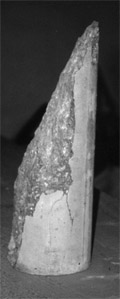
|
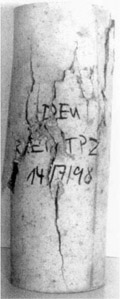
|
| Figure 6: Fracture shape of plain concrete | Figure 7: Fracture shape of PFR concrete |
Fracture Properties: The failure behaviour of high-strength concretes is effectively improved by the use of fibers. The typical shear bond rupture due to strain localization could be avoided (fig. 6). Instead of this, a large number of the longitudinal cracking, which was predominantly oriented in the direction parallel or sub-parallel to the external compressive stresses, was formed at the entire concrete specimens as shown in fig7.
Creep and shrinkage properties of concrete: Fibers reduce creep strain, which is defined as the time-dependent deformation of concrete under a constant stress. Compressive creep values, however, may be only 10 to 20% of those for normal concrete. Shrinkage of concrete, which is caused by the withdrawal of water from concrete during drying, is also reduced by fibers. The shrinkage, creep and total time dependent deformation of various PFRC mixes along with non fibrous concrete mix are presented in fig 8[15]. The reduction in shrinkage due to the presence of fibers is expected from number of viewpoints. First, the fibers do not exhibit any shrinkage, thus reducing overall shrinkage of the mix. In addition the fibers have a role in retaining the water in the concrete mix upto a certain limit which helps to delay the shrinkage. Therefore addition of fibers to the concrete mixes is always advantageous in reducing shrinkage deformation.
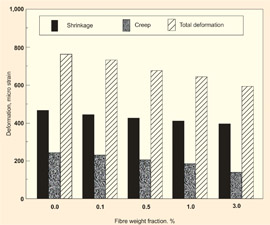
|
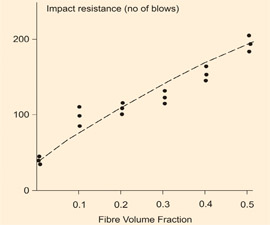
|
| Figure 8: Time dependent deformation of polypropylene fibers | Figure10: Effect of polypropylene fibers on impact resistance of concrete |
Flexural impact properties: The number of blows required to develop the first visible crack on the beam’s lower surface is defined as the initial-crack impact number (Ncr). Failure impact number Nf is defined as the number at which one main macro-crack develops from bottom to top of the beam. Impact ductility index is defined as the ratio of failure impact number to initial crack impact number, which can be used to present the flexural impact ductility.
J=Nf / Ncr
where J is impact ductility index, which for plain concrete is 1. The flexural impact test results are shown in table 6 by researcher[10]. The impact resistance for concretes with various volume fractions of fibrillated polypropylene fibers has been shown in figure 10. The results indicate that significant improvement in impact resistance of concrete can be achieved with relatively low volume fraction of polypropylene fibers.
| Table 6: Impact properties of fiber reinforced concrete | ||||
| Type of mix | Vf % | Average Impact number | Average failure Impact number |
Impact ductility index |
| Control | 0 | 25.8 | 26.8 | 1.04 |
| Microfilament | 0.05 0.095 0.14 |
34.7 28.6 38.1 |
46.5 30.4 40.1 |
1.34 1.06 1.05 |
| Monofilament | 1 1.2 1.4 |
68.9 70.7 62.8 |
224.2 712.7 831 |
3.26 10.08 13.23 |
Chloride penetration: Besides improved mechanical properties due to inclusion of fiber, chloride penetration is also reduced substantially by the presence of fibers depending upon its orientation. Antoni [17] studied the effect of chloride penetration and found that the effect is insignificant for shorter fiber due to the random orientation of short fibers as compare to long fibers. Further, the chloride movement into concrete is reduced significantly by the presence of fiber as the interfacial transition zone in the direction perpendicular to the chloride penetration whereas fiber provides easier path for the chloride to migrate in direction along the fiber.
Obstacles in Use of PFRC
Although PP fibers are gaining wide applications in many fields, there is still need for improvement in some properties. A major fire will leave the concrete with additional porosity equal to the volume of fibers incorporated in the concrete usually in the order of 0.3 to 1.5% by volumetric fraction. In respect of monofilament fibers, the poor bond between fiber and matrix results in a low pull out strength. The PP fibers are also attacked by sunlight and oxygen, however surrounding concrete in PFRC protects the fibers so well that this shortcoming is not significant. Further, sometimes the fibers function as initiator of the micro cracking because of their low modulus of elasticity as compared to the cement matrix. Thus mechanical bond with the cement matrix is also low. The fibers cause the enhancement of the pores volume of concrete by creating more micro-defects in the cement matrix.
Conclusion
Innovations in engineering design and construction, which often call for new building materials, have made polypropylene fiber-reinforced concrete applications. In the past several years, an increasing number of constructions have been taken place with concrete containing polypropylene fibres such as foundation piles, prestressed piles, piers, highways, industrial floors, bridge decks, facing panels, flotation units for walkways, heavyweight coatings for underwater pipe etc. This has also been used for controlling shrinkage & temperature cracking.
Due to enhance performances and effective cost-benefit ratio, the use of polypropylene fibers is often recommended for concrete structures recently. PFRC is easy to place, compact, finish, pump and it reduces the rebound effect in sprayed concrete applications by increasing cohesiveness of wet concrete. Being wholly synthetic there is no corrosion risk. PFRC shows improved impact resistance as compared to conventionally reinforced brittle concrete. The use of PFRC provides a safer working environment and improves abrasion resistance in concrete floors by controlling the bleeding while the concrete is in plastic stage. The possibility of increased tensile strength and impact resistance offers potential reductions in the weight and thickness of structural components and should also reduce the damage resulting from shipping and handling.
Acknowledgment
The author wishes to express his sincere thanks to Ms Sonal Dhanvijay & Ms Vedanti Ganwir of Visvesvaraya National Institute of Technology, Nagpur for their valuable help in preparing this paper.
Due to enhance performances and effective cost-benefit ratio, the use of polypropylene fibers is often recommended for concrete structures recently. PFRC is easy to place, compact, finish, pump and it reduces the rebound effect in sprayed concrete applications by increasing cohesiveness of wet concrete. Being wholly synthetic there is no corrosion risk. PFRC shows improved impact resistance as compared to conventionally reinforced brittle concrete. The use of PFRC provides a safer working environment and improves abrasion resistance in concrete floors by controlling the bleeding while the concrete is in plastic stage. The possibility of increased tensile strength and impact resistance offers potential reductions in the weight and thickness of structural components and should also reduce the damage resulting from shipping and handling.
Acknowledgment
The author wishes to express his sincere thanks to Ms Sonal Dhanvijay & Ms Vedanti Ganwir of Visvesvaraya National Institute of Technology, Nagpur for their valuable help in preparing this paper.
References
- Saenz, A., Rivera, E., Brostow, W. and Castan˜o, V.M., "J. Mater," (Ed.), Vol..21, No.267 (1999).
- Castan˜o, V. M. and Rodriguez, J. R., "Performance of Plastics" Ch 24, Brostow, W., ed., Hanser, Munich-Cincinnati (2000).
- Dodson, V., "Concrete and Mixtures" Van Nostrand Reinhold: Structural Engineering Series, New York (1989).
- Sheldon, R. R.,"Composite Polymer Materials" Applied Science Publishers, London (1982).
- Ramaswamy, H. S., Ahuja, B. M. and Krishnamoorthy, S., "J. Mex. Inst. Cement Concrete" Vol. 22,No. 161 (1984).
- Jindal, C. V., " J. Composite Materials," Vol.20, No.265 (1986).
- Beaudoin, J. J., "Handbook of Fibre Reinforced Concrete" Noyes Publications, New Jersey (1990).
- Colling, J., " J. Mex. Inst. Cement Concrete" Vol. 19, No. 127 (1981).
- Hananth, D. J., "Fiber Cements and Fiber Concretes" A Wiley-Inter science Publication, John Wiley and Sons, Ltd pp 81-98.
- Deng, Z., and Li, J., "Tension and Impact Behaviours of New Type Fibre Reinforced Concrete." Computers and Concrete, Vol. 4, No. 1 (2007) pp. 19-32.
- Bentur, A. and Mindess, S., "Fiber Reinforced Cementitious Composites," Elsevier Science Publishers Ltd. Ch 10, pp 310-330.
- "High performance concrete" A state of art report (1989-1994).
- Bruce, P., "Effective Use of Polypropylene Fibers in Concrete," SCI Seminar 2004.
- Aulia, T. B., "Effects of Polypropylene Fibers on the Properties of High-Strength Concretes." LACER No. 7 (2002), pp.43-59.
- Waheeb, A. L. K., "Mechanical Properties and Time Dependent Defor- mations of Polypropylene Fibre Reinfor- ced Concrete," J King Saud Univ., Vol. 7, Eng.Sci. (1) (1993),pp. 67-76.
- Choi, Y., Yuan, R.L., "Experimental Relationship between Splitting Tensile Strength and Compressive Strength of GFRC and PFRC", Cement and Concrete Research, Vol. 35 (2005) pp.1587-1591.
- Antoni, Honguchi T. and Saeki N."Influence of Stress on Chloride Penetration into Fiber Reinforced Concrete ", JCI,Vol.25 (2003), pp.779-784.
- Malisch,W. R., "Polypropylene fibers in concrete."
- Sukontasukkul, P., "Toughness Valuation of Steel and Polypropylene Fibre Reinforced Concrete Beams under Bending" Thammasat Int. J. Sc. Tech., Vol. 9, No. 3, (2004),pp.35-41.
- Ritchie, A.G.B. and Mackintosh, D.M., "Selection and Rheological Characteristics of PP fibers," Concrete, pp 36-39 (1972).
- Hughes, B.P. and Fattuhi, N.I., "Fibrer Reinforced Concrete in Direct Tension," Fiber Reinforced Materials, paper 16, conference at Institution of Civil Engineers, London. 1977, pp 127-133.
- Hadi, M. N. S., "An Investigation of the Behaviour of Steel and Polypropylene Fibre Reinforced Concrete Slabs," 7th International Conference. Concrete: Construction’s Sustainable Option - Harnessing Fibres for Concrete Construction, Dundee, Scotland, 8-10 July 2008.
- Suhaendi, S. L., "Residual Strength and Permeability of Hybrid Fiber Reinforced High Strength Concrete Exposed to High Temperature" Part of Ph. D. Thesis.
- Alidoust, O., Sadrinejad, I. and Ahmadi, M. A., "A Study on Cement-Based Composite Containing Polypropylene Fibers and Finely Ground Glass Exposed to Elevated Temperatures." Procedings of World Academy of Science, Engineering and Technology Vol. 23.
- Suji, D., Natesan, S. C., Murugesan, R., "Experimental study on behaviors of polypropylene fibrous concrete beams" Journal of Zhejiang University SCIENCE A pp 1862-1775.
- Carnio, M. A., Gomes, A. E. and Lintz, R. C. C., "Fiber reinforced Concrete" Technical Report on Average Residual Strength (ARS), ASTM C 1399-7a.
- Wang Y., Victor C. Li., Backer S., "Tensile Properties of Synthetic Fiber Reinforced Mortar," Cement and Concrete Composites Vol.12 (1990) pp 29-40.
- Singh S.K.et.al. "Internal Report on Steel Free Deck Slab",SERC, Ghaziabad (2000)
- Shiv Kumar, A. & Sathanam,M. "Machanical Properties of High Strength Concrete Reinforced with Metallic and Non Metallic Fibres",Cement & Concrete Composites, Vol.27(2007),pp.603-608.
- Xing, L.B.;Xiang C.M.; Farg C. & Luping L. "The Mechanical Properties of Polyproplene Fiber Reinforced Concrete", Journal of Wahan University of Technology, Material Science ED.,Vol.19, No.3 (2004), pp.68-71.
NBM&CW December 2011















